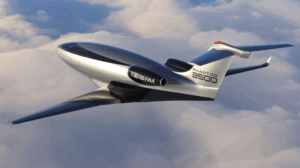BENTONVILLE, Ark. / JACKSONVILLE, Fla. ŌĆö Otto Aerospace has unveiled the Phantom 3500, a revolutionary business jet that may redefine the future of private aviation. With its sleek, windowless fuselage and laminar-flow aerodynamics, the aircraft aims to cut fuel burn by up to 60 percent compared with todayŌĆÖs midsize and super-midsize jetsŌĆöwhile offering passengers an entirely new in-flight experience.
The Phantom 3500 is unlike any business aircraft before it. Designed with a perfectly smooth carbon-fiber outer shell free from visible rivets or seams, the jet maintains uninterrupted laminar airflow, dramatically reducing aerodynamic drag. Traditional cabin windows are replaced by the SuperNatural Vision System, which projects real-time exterior views onto large, high-definition displays along the cabin walls. The result is a futuristic, panoramic environment that brings the outside world inside without compromising the aircraftŌĆÖs aerodynamic purity.
Power, Performance, and Range
Propelled by two Williams FJ44-4 turbofan engines, each producing approximately 3,600 pounds of thrust, the Phantom 3500 is designed to cruise at 740 km/h (460 mph) and reach altitudes up to 15,500 meters (51,000 feet). This altitude not only allows smoother flights above weather and turbulence but also reduces visible contrails. With an estimated range of 6,500 kilometers (3,500 nautical miles), the aircraft can operate nonstop on routes such as New YorkŌĆōBerlin or Los AngelesŌĆōHonolulu, connecting continents efficiently and sustainably.
A Major Launch Order and Manufacturing Expansion
Otto Aerospace announced a firm order for 300 aircraft from fractional ownership leader Flexjet, marking one of the largest single commitments in business aviation history. The estimated list price is $19.5 million USD per aircraft, placing the total contract value at nearly $6 billion USD.
To support production, Otto Aerospace will relocate its headquarters and establish a new manufacturing facility at Cecil Airport in Jacksonville, Florida, backed by approximately $515 million USD in combined state and local incentives. Construction of the primary facility is expected to begin later this decade, with interim assembly operations in a leased hangar.
Development Timeline
The Phantom 3500 is now advancing through detailed design and supplier integration. First flight is targeted for 2027, followed by a comprehensive flight-test and certification campaign under FAA Part 23 regulations. Entry into service is planned for 2030, with initial deliveries to Flexjet and additional customers worldwide.
Industry and Public Reaction
Aviation analysts have described the Phantom 3500 as one of the most daring clean-sheet designs in decades. Industry publications praised its engineering ambition and the scale of the Flexjet order, noting its potential to disrupt conventional business-jet economics. Mainstream outlets have highlighted both its aerodynamic innovation and its windowless cabin, sparking debate over comfort and aesthetics. Early market response suggests equal measures of excitement and curiosity about a design that merges aerospace efficiency with digital immersion.
About Otto Aerospace
Founded in the United States, Otto Aerospace focuses on advanced aerodynamics and sustainable propulsion concepts for next-generation business aircraft. With the Phantom 3500 program, the company aims to combine environmental responsibility, operational efficiency, and a reimagined passenger experience to set a new benchmark in private aviation. (hz)
Planned first flight: 2027
Planned entry into service: 2030
Estimated list price: Ōēł $19.5 million USD per aircraft
Launch customer: Flexjet (300 firm orders)
Manufacturing location: Cecil Airport, Jacksonville, Florida
Photos: Otto Aerospace


